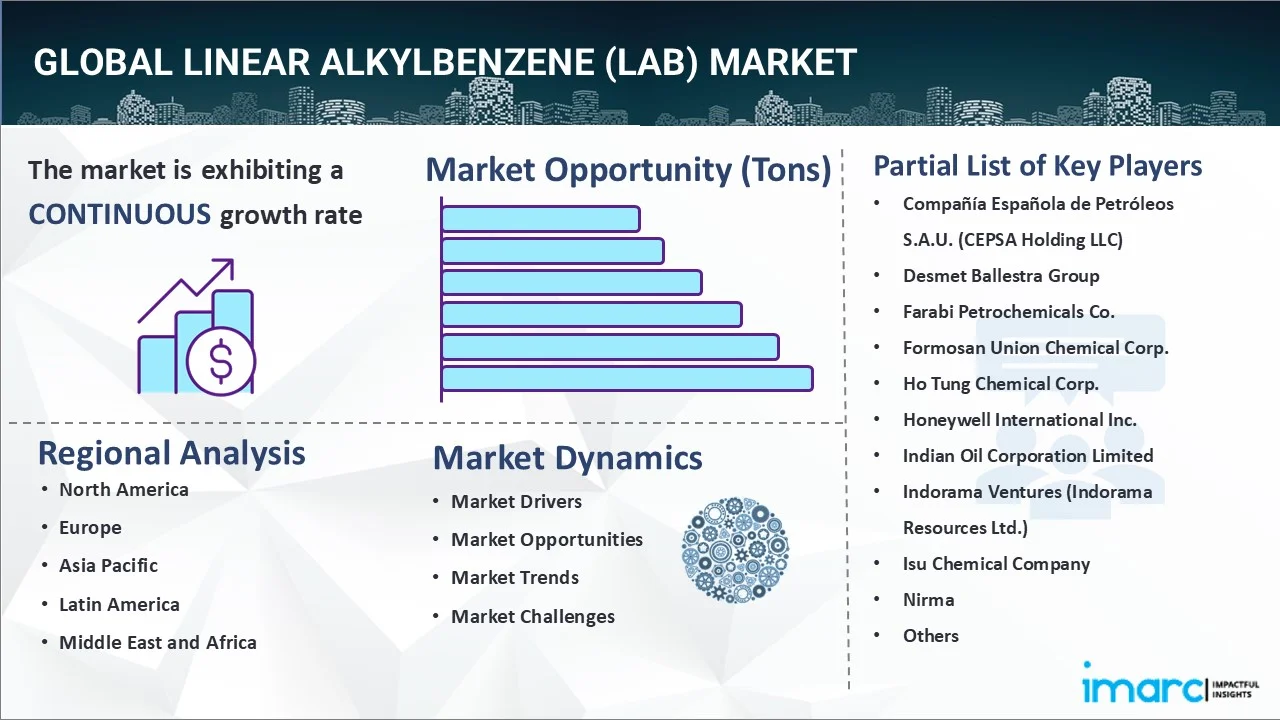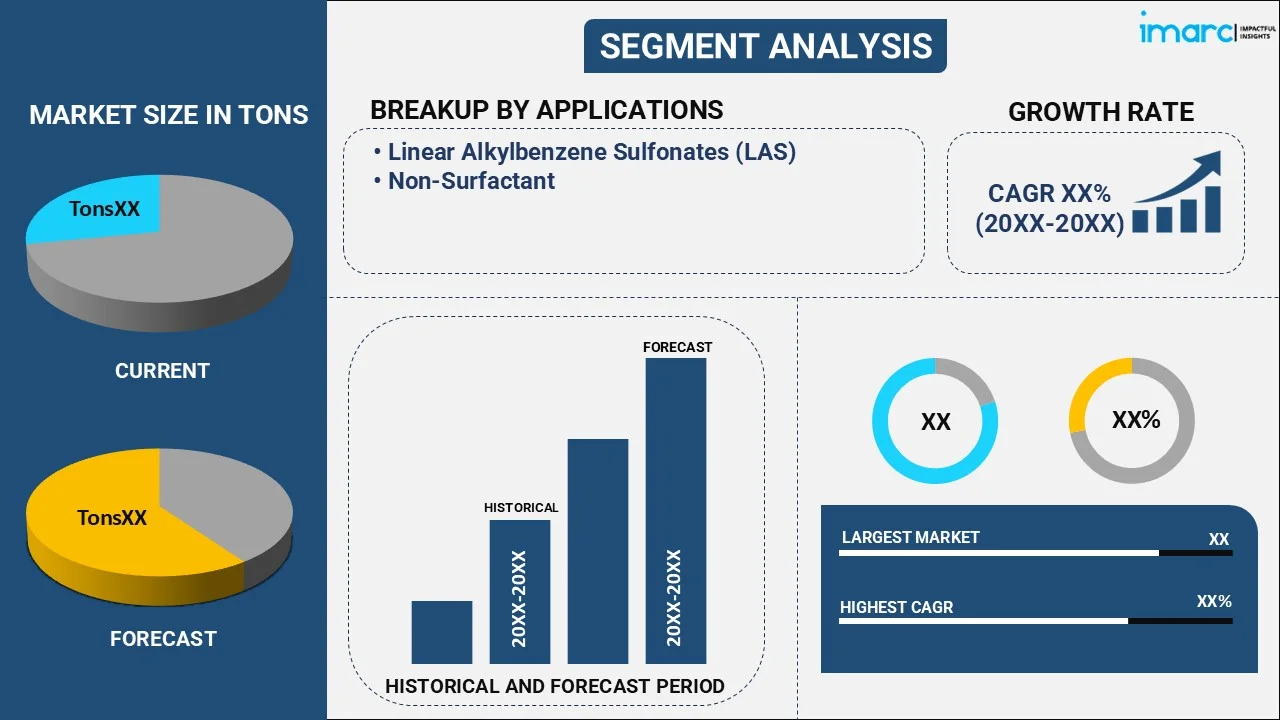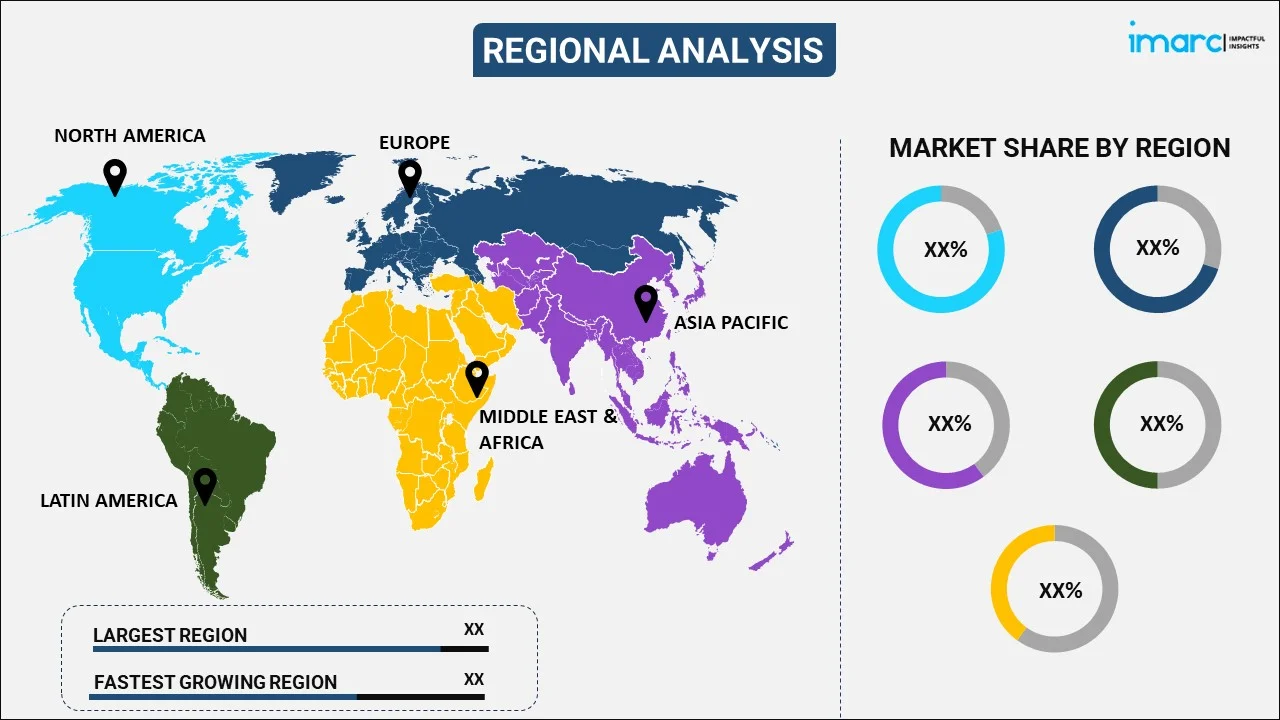
Linear Alkylbenzene (LAB) Market Report by Application (Linear Alkylbenzene Sulfonates (LAS), Non-Surfactant), End User (Laundry Detergents, Light-Duty Dishwashing Liquids, Industrial Cleaners, Household Cleaners, and Others), and Region 2025-2033
Market Overview:
The global linear alkylbenzene (LAB) market size reached 4.6 Million Tons in 2024. Looking forward, IMARC Group expects the market to reach 6.2 Million Tons by 2033, exhibiting a growth rate (CAGR) of 3.37% during 2025-2033. Rising product utilization in manufacturing detergent and cleaners, widespread product adoption in industrial applications, and the development of new production methods represent some of the key factors driving the market.
|
Report Attribute
|
Key Statistics
|
|---|---|
|
Base Year
|
2024
|
|
Forecast Years
|
2025-2033
|
|
Historical Years
|
2019-2024
|
|
Market Size in 2024
|
4.6 Million Tons |
|
Market Forecast in 2033
|
6.2 Million Tons |
| Market Growth Rate 2025-2033 | 3.37% |
Linear alkylbenzene (LAB) is a transparent and odorless organic compound used as an intermediate in the production of detergents and surfactants. It is produced using various petrochemical products, such as kerosene, n-paraffin, and benzene, through hydrogen fluoride (HF) and aluminum trichloride (AlCl3) processes. LAB is widely used in producing powder detergents, household cleaners, agricultural herbicides, polymers, electric cable oils, and solvents for ink and paints. It is also used as an emulsifier, emollient, moisturizing, degreasing, wetting, and de-coloring agent. LAB is a cost-effective and biodegradable compound that easily removes oil and fatty acids from fabrics and textiles. It is also chemically stable, slightly soluble in water, and has a high flash point. As a result, LAB finds extensive applications across the detergent, textile, paper, and polymer industries.

Linear Alkylbenzene (LAB) Market Trends:
The rising product utilization in detergents and cleaners is one of the primary factors driving the market growth. Linear alkylbenzene (LAB) is widely used to produce linear alkylbenzene sulfonate (LAS), which is a chemical surfactant used in manufacturing household cleaners, detergents, washing powder, liquid soap, scouring sticks, oil soap, industrial cleaners, and dishwashing liquids due to its high performance, low cost, and non-toxicity. In addition to this, the widespread product utilization to produce linear alkylbenzene sulfonic acid (LBSA), which is used as an emulsifier, mercerizing agent, and wetting agent in textiles, pesticides, lathering applications, and polymerization, is acting as another growth-inducing factor. Furthermore, the rising product demand to produce heavy linear alkyl benzene (HLAB) used for various industrial applications, such as heat transfer fluids, refrigeration lubricants, oils, metal working fluids, and rubber compounding, is providing an impetus to the market growth. Additionally, the introduction of new production methods, such as the Detal process that uses solid catalysts, including zeolites and metal oxides, to improve linearity, minimize acidic discharge, enhance quality, maximize product yield, and eliminate the need for effluent treatment is positively influencing the market growth. Moreover, rising product adoption as a solvent for large-scale liquid scintillator detectors due to its high flash point, low toxicity, good optical transparency, low radioactive impurity, and excellent compatibility with acrylic is propelling the market growth. Other factors, including rapid industrialization, rising adoption of biodegradable surfactants due to increasing environmental concerns, escalating demand for personal hygiene and cleanliness, and the widespread product utilization in the paper industry as a de-coloring agent, are anticipated to drive the market growth.
Key Market Segmentation:
IMARC Group provides an analysis of the key trends in each segment of the global linear alkylbenzene (LAB) market, along with forecasts at the global, regional, and country level from 2025-2033. Our report has categorized the market based on application and end user.
Application Insights:

- Linear Alkylbenzene Sulfonates (LAS)
- Non-Surfactant
The report has provided a detailed breakup and analysis of the linear alkylbenzene (LAB) market based on the application. This includes linear alkylbenzene sulfonates (LAS) and non-surfactant. According to the report, linear alkylbenzene sulfonates (LAS) represented the largest segment.
End User Insights:
- Laundry Detergents
- Light-Duty Dishwashing Liquids
- Industrial Cleaners
- Household Cleaners
- Others
A detailed breakup and analysis of the linear alkylbenzene (LAB) market based on the end user has also been provided in the report. This includes laundry detergents, light-duty dishwashing liquids, industrial cleaners, household cleaners, and others. According to the report, laundry detergents accounted for the largest market share.
Regional Insights:

- North America
- United States
- Canada
- Asia Pacific
- China
- Japan
- India
- South Korea
- Australia
- Indonesia
- Others
- Europe
- Germany
- France
- United Kingdom
- Italy
- Spain
- Russia
- Others
- Latin America
- Brazil
- Mexico
- Others
- Middle East and Africa
The report has also provided a comprehensive analysis of all the major regional markets that include North America (the United States and Canada); Asia Pacific (China, Japan, India, South Korea, Australia, Indonesia, and others); Europe (Germany, France, the United Kingdom, Italy, Spain, Russia, and others); Latin America (Brazil, Mexico, and others); and Middle East and Africa. According to the report, Asia Pacific was the largest market for linear alkylbenzene (LAB). Some of the factors driving the Asia Pacific linear alkylbenzene (LAB) market included significant growth in end use industries, the availability of raw materials at affordable prices, and an increasing number of manufacturers.
Competitive Landscape:
The report has also provided a comprehensive analysis of the competitive landscape in the global linear alkylbenzene (LAB) market. Detailed profiles of all major companies have also been provided. Some of the companies covered include Compañía Española de Petróleos S.A.U. (CEPSA Holding LLC), Desmet Ballestra Group, Farabi Petrochemicals Co., Formosan Union Chemical Corp., Ho Tung Chemical Corp., Honeywell International Inc., Indian Oil Corporation Limited, Indorama Ventures (Indorama Resources Ltd.), Isu Chemical Company, Nirma, Reliance Industries Limited, Sasol Limited, Stepan Company, etc. Kindly note that this only represents a partial list of companies, and the complete list has been provided in the report.
Report Coverage:
| Report Features | Details |
|---|---|
| Base Year of the Analysis | 2024 |
| Historical Period | 2019-2024 |
| Forecast Period | 2025-2033 |
| Units | Million Tons, Billion USD |
| Segment Coverage | Application, End User, Region |
| Region Covered | Asia Pacific, Europe, North America, Latin America, Middle East and Africa |
| Countries Covered | United States, Canada, Germany, France, United Kingdom, Italy, Spain, Russia, China, Japan, India, South Korea, Australia, Indonesia, Brazil, Mexico |
| Companies Covered | Compañía Española de Petróleos S.A.U. (CEPSA Holding LLC), Desmet Ballestra Group, Farabi Petrochemicals Co., Formosan Union Chemical Corp., Ho Tung Chemical Corp., Honeywell International Inc., Indian Oil Corporation Limited, Indorama Ventures (Indorama Resources Ltd.), Isu Chemical Company, Nirma, Reliance Industries Limited, Sasol Limited, Stepan Company, etc. |
| Customization Scope | 10% Free Customization |
| Post-Sale Analyst Support | 10-12 Weeks |
| Delivery Format | PDF and Excel through Email (We can also provide the editable version of the report in PPT/Word format on special request) |
Key Benefits for Stakeholders:
- IMARC’s report offers a comprehensive quantitative analysis of various market segments, historical and current market trends, market forecasts, and dynamics of the linear alkylbenzene (LAB) market from 2019-2033.
- The research study provides the latest information on the market drivers, challenges, and opportunities in the global linear alkylbenzene (LAB) market.
- The study maps the leading as well as the fastest growing regional markets. It further enables stakeholders to identify the key country-level markets within each region.
- Porter's five forces analysis assist stakeholders in assessing the impact of new entrants, competitive rivalry, supplier power, buyer power, and the threat of substitution. It helps stakeholders to analyze the level of competition within the linear alkylbenzene (LAB) industry and its attractiveness.
- Competitive landscape allows stakeholders to understand their competitive environment and provides an insight into the current positions of key players in the market.
Key Questions Answered in This Report
The global Linear Alkylbenzene (LAB) market reached a volume of 4.6 Million Tons in 2024.
We expect the global Linear Alkylbenzene (LAB) market to exhibit a CAGR of 3.37% during 2025-2033.
The rising demand for Linear Alkylbenzene (LAB) across the textile industry, as it is chemically stable, slightly soluble in water, and has a high flash point that easily removes oil and fatty acids from fabrics and textiles, is primarily driving the Linear Alkylbenzene (LAB) market.
The sudden outbreak of the COVID-19 pandemic had led to the implementation of stringent lockdown regulations across several nations, resulting in the temporary halt in numerous production activities for Linear Alkylbenzene (LAB).
Based on the application, the global Linear Alkylbenzene (LAB) market has been divided into Linear Alkylbenzene Sulfonates (LAS) and non-surfactant. Currently, Linear Alkylbenzene Sulfonates (LAS) hold the majority of the total market share.
Based on the end user, the global Linear Alkylbenzene (LAB) market can be segmented into laundry detergents, light-duty dishwashing liquids, industrial cleaners, household cleaners, and others. Among these, laundry detergents exhibit a clear dominance in the market.
On a regional level, the market has been classified into North America, Asia Pacific, Europe, Latin America, and Middle East and Africa, where Asia Pacific currently dominates the global market.
Some of the major players in the global Linear Alkylbenzene (LAB) market include Compañía Española de Petróleos S.A.U. (CEPSA Holding LLC), Desmet Ballestra Group, Farabi Petrochemicals Co., Formosan Union Chemical Corp., Ho Tung Chemical Corp., Honeywell International Inc., Indian Oil Corporation Limited, Indorama Ventures (Indorama Resources Ltd.), Isu Chemical Company, Nirma, Reliance Industries Limited, Sasol Limited, Stepan Company, etc.
Need more help?
- Speak to our experienced analysts for insights on the current market scenarios.
- Include additional segments and countries to customize the report as per your requirement.
- Gain an unparalleled competitive advantage in your domain by understanding how to utilize the report and positively impacting your operations and revenue.
- For further assistance, please connect with our analysts.
 Inquire Before Buying
Inquire Before Buying
 Speak to an Analyst
Speak to an Analyst
 Request Brochure
Request Brochure
 Request Customization
Request Customization




.webp)




.webp)












